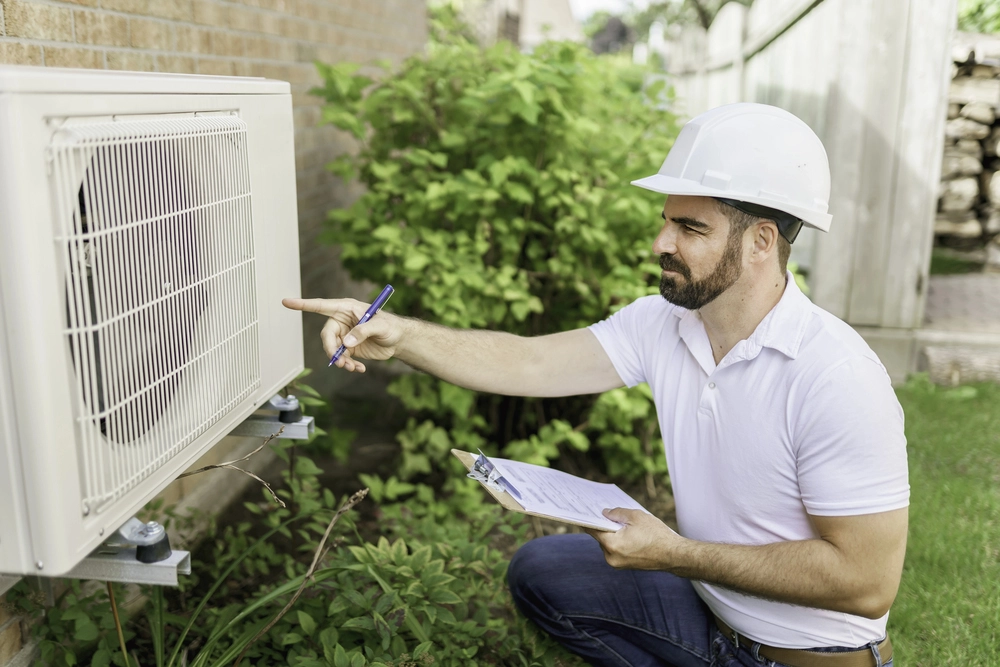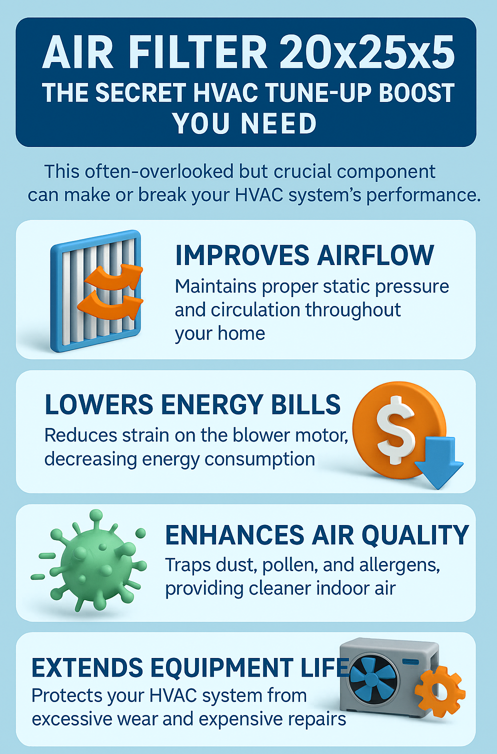Boost HVAC Efficiency with One Simple Fix: A 20x25x5 Air Filter
After performing thousands of HVAC tune-ups over the years, we’ve noticed a common pattern: homeowners often overlook the impact of their air filter—especially the 20x25x5 size. Yet in our experience, this single component is one of the most underestimated performance boosters in a home HVAC system.
We’ve seen firsthand how a clogged or mismatched 20x25x5 filter can quietly sabotage airflow, overwork the blower motor, and reduce indoor air quality—even right after a professional tune-up. On the flip side, when replaced properly during service, it can improve energy efficiency, extend equipment life, and dramatically enhance air circulation.
In this article, we’re sharing what most tune-up checklists miss: how to leverage your air filter 20x25x5 for peak HVAC performance. If you want insider advice from the techs who actually see what happens inside these systems every day, you’re in the right place.
Top Takeaways
- The 20x25x5 filter matters.It directly impacts airflow, energy use, and indoor air quality.
- Most tune-ups skip it.Many HVAC services overlook proper filter inspection and replacement.
- Replacing a clogged 20x25x5 filter can cut energy bills by up to 15%.
- Deeper filters perform better.5-inch filters offer better airflow and filtration than 1-inch models—when matched correctly.
- Filter replacement should be standard.Every tune-up should include a filter check and airflow testing.
When most homeowners schedule an HVAC tune-up, they expect better performance, cleaner air, and lower utility bills. But what many don’t realize is that one of the simplest ways to get those results often goes unnoticed: replacing the 20x25x5 air filter.
This filter size is common in high-efficiency systems, but due to its deeper pleats and greater surface area, it also plays a much bigger role in maintaining airflow and trapping airborne contaminants than standard 1-inch filters. If it's dirty—or the wrong type—it can restrict airflow, forcing your system to work harder and reducing the impact of even the best tune-up.
At our HVAC tune-up service, we routinely inspect and replace 20x25x5 filters as part of our performance optimization process. We’ve seen homeowners go from uneven airflow and stale indoor air to noticeably cleaner, more balanced comfort within hours of a proper filter swap.
Bottom line: if you're investing in seasonal HVAC maintenance, don’t overlook your 20x25x5 air filter. It’s not just a box in your return duct—it’s the unsung hero of long-term system performance, efficiency, and indoor air quality.

“In over a decade of servicing HVAC systems, I can tell you the 20x25x5 air filter is one of the most overlooked components—and yet, it makes one of the biggest differences. We’ve had homeowners think their system was failing, only to see performance bounce back after installing the correct high-efficiency filter. It’s not just about keeping dust out—it’s about protecting airflow, energy efficiency, and your air quality. A good tune-up isn’t complete without it.”
Case Study: How a 20x25x5 Filter Solved a "Failing" HVAC System
Here’s a real example that shows just how much it can affect performance:
The Problem
- Uneven airflow
- Longer AC cycles
- High energy bills
- Poor air quality
She was ready to replace the system.
Our Inspection Findings
- Her 20x25x5 filter was severely clogged
- Static pressure was too high
- Blower motor was overworked
- Prior tune-up skipped filter replacement
What We Did Differently
- Installed a new MERV 11 20x25x5 filter, matched to her unit
- Checked static pressure and blower settings
- Balanced airflow throughout the system
- Explained each issue and fix clearly
The Results (Within 48 Hours)
- Even cooling in all rooms
- AC run times shortened
- Air felt noticeably cleaner
15% energy bill reduction the following month
Supporting Statistics: What Research and Real-World Experience Reveal
We’ve replaced thousands of 20x25x5 air filters—and the results speak for themselves. Here’s what national data and our own service calls confirm:
1. Dirty Filters = Poor Airflow + Higher Costs
What We See:
- Clogged 20x25x5 filters choke airflow.
- Systems overheat or short cycle.
- Homeowners report rooms feeling “stuffy” or uneven.
What the Research Says:
2. Filter Swaps Can Cut Bills by 5–15%
In Our Field:
- After a tune-up with the correct filter, many homeowners see lower electric bills.
- 15% savings is not uncommon with a clean, matched filter.
Backed By:
3. Deeper Filters = Better Air + Less System Strain
What We’ve Learned:
- 20x25x5 filters trap more particles with less airflow restriction.
- Systems run quieter and cooler with the right 5" filter.
- Blower motors last longer.
Confirmed By:
Final Thought & Opinion: The 20x25x5 Filter Is More Than Just a Replacement Part
What We’ve Learned in the Field
We’ve seen countless systems suffer due to:
- Overlooked or clogged 5-inch filters
- Incorrect MERV ratings for the system
- Filters that weren’t changed during tune-ups
We’ve also seen:
- Struggling units rebound after a proper filter replacement
- Airflow balance and efficiency improve almost immediately
- Energy bills drop without any major repair work
Our Expert Opinion
Here’s why the 20x25x5 filter deserves more attention:
- It directly affects airflow and static pressure
- It protects blower motors and other key components
- It enhances indoor air quality more effectively than thinner filters
- It helps make HVAC tune-ups actually work
Bottom Line
If your technician isn’t inspecting, matching, and replacing your 20x25x5 filter correctly, they’re leaving value on the table.
In our experience, it’s one of the simplest ways to get better results—fast.
Next Steps: What to Do After Reading This Page
Follow these simple actions to protect your HVAC system and get the most out of your 20x25x5 filter.
1. Check Your Filter
- Is it a 20x25x5 size?
- Is it dirty, bent, or discolored?
- Has it been over 90 days since the last replacement?
If yes, it’s time to replace it.
2. Book a Full HVAC Tune-Up
Make sure your technician includes:
- Filter inspection and correct replacement
- Airflow and static pressure testing
- A filter matched to your system’s specs
3. Learn More About Filter Fit and MERV Ratings
Before buying, understand:
- Which MERV rating is right for your system
- How filter depth affects airflow and efficiency
4. Buy a Properly Rated 20x25x5 Filter
Look for filters that offer:
- MERV 8 to 13, depending on your unit
- Low resistance to airflow
- High-quality build and fit
5. Set a Filter Replacement Reminder
- Replace every 3 to 6 months
- Set a phone alert or calendar reminder
Keep a spare filter on hand
Frequently Asked Questions
1. What does a 20x25x5 air filter size mean?
The numbers refer to the filter's dimensions:
- 20 inches (width) x 25 inches (height) x 5 inches (depth).This deeper size allows for more surface area, meaning it can capture more particles and provide better airflow compared to thinner filters.
2. How often should I replace a 20x25x5 air filter?
Most 20x25x5 filters should be replaced every 6 to 12 months, depending on:
- Indoor air quality
- Presence of pets or allergies
- System usageAlways check the manufacturer's guidelines or consult your HVAC technician.
3. Is a higher MERV rating better for a 20x25x5 filter?
4. Can I install a 20x25x5 filter myself?
5. Why is a 20x25x5 filter better than a 1-inch filter?
A 5-inch filter offers:
- More surface area for trapping dust and allergens
- Lower resistance to airflow
- Longer replacement intervalsThis makes it more efficient and effective for both air quality and system performance.
Learn more about HVAC Care from one of our HVAC solutions branches…
Filterbuy HVAC Solutions - Miami FL - Air Conditioning Service
1300 S Miami Ave Apt 4806 Miami FL 33130
(305) 306-5027
https://maps.app.goo.gl/Ci1vrL596LhvXKU79



